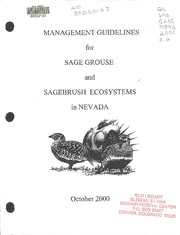
Management guidelines for sage grouse and sagebrush ecosystems in Nevada. PDF
Preview Management guidelines for sage grouse and sagebrush ecosystems in Nevada.
BLMLIBRARY 88052157 • MANAGEMENT GUIDELINES xooo for SAGE GROUSE and SAGEBRUSH ECOSYSTEMS NEVADA in • October 2000 BLMLIBRARY • Introduction Thesemanagementguidelinesandsupportivebackgroundinformationpromotetheconservationof sagegrouse(Centrocercusurophasianus)andtheirsagebrush{Artemisiaspp)habitatsonNevada publiclands administeredbyBureauofLandManagement(BLM). Theguidelinesareintendedto provideinterimguidancetofieldmanagers,withoutrestrictingoptionscurrentlybeingexploredfor regional,state,andlocalsagegrouse/sagebrushconservationplanning. TheguidelinesareaNevadaBLM,habitat-specific,adaptationoftherecentlyupdated,andsoontobe finalized,WesternAssociationofWildlifeAgencies(WAFWA)DraftGuidelines. TheNevadaBLM guidelinesapplythemostcurrentsagegrousesciencetoBLMactivities,withinthecontextofa multipleusemandate. Sagegrousepopulationshaveexhibitedlong-termdeclinesthroughoutNorthAmerica,decliningby 33percentoverthepast30to40years(Braun1998). Thespeciesisextirpatedinfivestatesandone Canadianprovince,andisatriskinsixotherstatesandtwoCanadianprovinces.Eveninthefive Westernstateswherethespeciesisconsideredtobesecure,long-termpopulationdeclineshave averaged30percent(ConnellyandBraun1997,CrawfordandLutz1985).Nosinglecausalfactorhas beenidentifiedforthesedeclines.Rather,anaccumulationoffactorsdescribedhereinareresponsible. Existingguidancewithdirectbearingontheseguidelinesinclude: BLMNationalSpecialStatusSpeciesPolicy(BLM6840Manual) ThispolicystatesthatBLMshallensurethatactionsauthorized,funded,orcarriedoutdonot contributetotheneedtolistaspeciesundertheprovisionsoftheEndangeredSpeciesAct. StandardsforRangelandHealthandGuidelinesforLivestockGrazingManagementforPublicLands intheSierraFront/NorthwesternGreatBasinRACArea StandardsforRangelandHealthandGuidelinesforLivestockGrazingManagementforPublicLands intheNortheasternGreatBasinRACArea StandardsforRangelandHealthandGuidelinesforLivestockGrazingManagementforPublicLands intheMojave/SouthernGreatBasinRACArea WesternAssociationofFishandWildlifeAgenciesDraftGuidelinesforManagementofSage GrousePopulationsandHabitats(AppendixI).Thisdocumentisasoon-to-befinalizedupdateofa danodcuWmieldnltifwehiScehrvwicaes(fiFrWstSi)ssrueecdenitnly19s7i7g.neTdhaenBaLgrMe,emaelnotngtowciotnhstihdeerFotrheesWtSAeFrvWicAe(gFuSi)dealnidnetsheinFtihsehir rtheespWecAtiFveWpAlanguniidneglienfefosr,tsr.ecTohgneiNzienvgatdhaatBgLenMergaulildyelloinweesrhmaoviestbuereenrdeegviemleospperdevtaoilbethcroonsuigshtoeuntttwhieth majorityofNevada'ssagebrushecosystem. Mattersrelatedtofalconry,predatorcontrol,andhuntingarenotthepurviewoftheBLMbutare insteadadministeredbyotherfederalorstateagencies. Thesemanagementguidelinesareintendedto applyonlytoBLM-administeredactivitiesonpubliclands. DSNVB^%%^ 150A COL0^DO ' 8022g SageGrouseLifeHistory Overview Thesagegrousebreedingseasonbeginsinmid-Marchwhenthemalesstarttocongregateontheleks. InNevada,breedingactivitiestypicallyoccurfromMarchthroughmid-May. Leksarethebreedingor struttinggrounds. Femalescometothelekstomate. Theygenerallynestinthevicinity.Ahigh proportionofnestsarelocatedwithin6.2km(4mi.)ofthelekwhensuitablenestinghabitatexists. However,somestudieshaveshownthatfemalesagegrouseorhensnestasfaras20km(12mi.)away fromthelek(Autenrieth1981,Wakkinenetal.1992). Afterhatching,thehenandherbroodstayin thegeneralvicinityofthenestfor1ormoreweeks. Forthefirst3to4weeksafterhatching,chicks feedprimarilyoninsects,whichprovidethehighproteindietneededforrapidgrowth. Astheseason andplantphenologyprogress,henswillmovetheirbroodstohigherelevationormoremoisthabitats, suchasmeadows,wherehigherqualityfoodsareavailable. Forbs,suchasyarrowanddandelion,areanimportantfoodsourcetosagegrouse. Asforbsmature anddryoutandinsectavailabilitydeclineswiththeadvanceofsummer,thesagegrousedietincludes moresagebrushleavesandbuds. Duringlatefall,sagegrousefeedalmostexclusivelyonsagebrush andcontinuetofeedonsagebrushthroughoutthewinteruntilforbsreappearthefollowingspring. Becauseoftheirdependenceonsagebrush,thebirdsarecommonlyreferredtoassagebrushobligates. Forthisreason,thereismuchconcernovertheconditionanddistributionofsagebrushhabitats. Reproduction Sagegrousegenerallyhavelowerreproductiveratesandhigherannualsurvivalratesthanother speciesofuplandgamebirdssuchasquailandpartridge(ConnellyandBraun1997). Theyalsolive longerthanmostuplandgamebirdspecies-individualbirds4to5yearsoldarecommon. Annual reproductivesuccessvariesthroughoutthespecies'range(Gregg1991,WallestadandPyrah1974). Nestingrates Nestingratesvaryfromyeartoyearandfromareatoarea(Schroeder1997,Connellyetal.1993, Gregg1991,Bergerud1988,Coggins1998). Thisvariationismostlikelyaresultofavailable nutritionqualityandthegeneralhealthofpre-layingfemales(BarnettandCrawford1994).Atleast70 percentofthefemalesinapopulationwillinitiateanesteachyear. Highernestinitiationrateswere recordedduringyearsofhigherprecipitationascomparedtonestinitiationratesduringperiodsof drought(Coggins1998). Renestingratesbyfemaleswhohavelosttheirfirstclutchare10to40 percent—farlowerthanthatofotheruplandgamebirds(Connellyetal.1993,Patterson1952,Eng 1963,Petersen1980,Bergerud1988). Renestingmaydolittletoincreaseoverallpopulationnumbers. Nestsuccess Nestsuccessofsagegrousealsovariesbyareaandyear. Ofallthebirdsthatnest,10to86percent producechicks(Trueblood1954,Gregg1991,Connellyetal.1993,Schroeder1997). Adultfemales mayexperiencehighersuccessratesthanyearlingfemales(WallestadandPyrah1974),acharacteristic thatmayberelatedtopastnestingexperience. Clutchsize Clutch(anestofeggs)sizeofsagegrouseisvariableandrelativelylowascomparedtootherspecies ofgamebirds(Edminster1954,Schroeder1997). Clutchsizepernestnormallyrangesfromsevento teneggs(Connellyunpublisheddata,Schroeder1997,Wakkinen1990). Thesedifferencesmaybe relatedtohabitatqualityandoverallconditionofpre-layingfemales(Coggins1998). Survivalrates Annualsurvivalratesforyearlingandadultfemalesagegrousevaryfrom35percentto85percent; malesurvivalratesvaryfrom38percentto54percent(Wallestad1975,Zablan1993,Connellyetal. 1994). Lowersurvivalratesformalesmayberelatedtohigherpredationratesonmalesduringthe lekkingseason(Swenson1986). Astablesagegrousepopulationislargelydependentonthelevelofproductionofyoung,clutchsize, nestsuccess,chicksurvival,andadultsurvival. Amongwesternstates,long-termjuveniletohen ratioshavevariedfrom1.40to2.96juvenilesperheninthefall. Inrecentyears,thisratiohas declinedto1.21to2.19juvenilesperhen. Researchsuggeststhatatleast2.25juvenilesperhen shouldbepresentinthefallpopulationtoallowforstabletoincreasingsagegrousepopulations (ConnellyandBraun1997,Edelmannetal.1998,ComptonandConnellyunpub.data). SageGrouseHabitatRequirements Seasonalmovementsandhomerange Sagegrousepopulationscanbemigratoryornonmigratory(resident)(BerryandEng1985,Connelly etal.1988,Wakkinen1990,Fischer1994,Beck1975,Wallestad1975),dependingonlocationand associatedlandform. Wheretopographicreliefallows,sagegrousewillgenerallymoveupin elevationfromspringthroughfallassnowmeltandplantgrowthadvance. Nonmigratoryor m"iregsriadteonrty"ppooppuullaattiioonnss,msaeaysosnpaelndmotvheemeentnitresymeaayrweixtcheienda7n5arkema(10406.k5mm2i(.3)8.(6D1almkie.e)toarl.le1s9s63i,nsize. In TChoenrneelmlayyetbael.t1w9o8o8r)maonrdehsoemaesornaanlgreasnmgeasyienxscuecehdc1a,se5s0.0kFomr2e(x5a7m9pmlie.,2)th(eCroennmealylybuenapubbr.eeddaitna)g.range, abrood-rearingrange,andawinterrange, indicatingthatmigratorysagegrousepopulationsdepend onlargeexpansesofhabitat. Toaccommodatethesehabitatneeds,sagegrousemovementpatternsandseasonalrangesmustbe identifiedbeforeanymanagementactionssuchasvegetationtreatmentprojectsareplanned. Large expansesofsuitablehabitatareneededtoallowforconnectivitybetweenthedifferentresident populations. Connectivitypromotesgeneticexchangeandreducescomplicationsthatmayarisefrom inbreeding. BREEDINGHABITATS(MarchthroughMay) Sagegrousebreedonsitescalledleksorstruttinggrounds. Generally,theleksitesaretraditional,that is,thesameleksitesareusedyearafteryear. Theyareestablishedinopenareassurroundedby sagebrush,whichisusedforescapeandprotectionfrompredators(Patterson1952,Gill1965). Examplesofleksitesincludelandingstrips;oldlakebedsorplayas;lowsagebrushflats;openingson ridges,roadsandcropland;andburnedareas(Connellyetal.1981,Gates1985). Asgrouse populationsdecline,thenumberofmalesattendingleksmaydecline,ortheuseofsomeleksmaybe discontinued. Likewise,aspopulationsincrease,maleattendanceonleksincreases,newleksmaybe established,oroldleksmaybere-occupied. Newleksmaybeestablishedwhennaturalorprescribed disturbancesresultinsuitablelekhabitatinsagegrouserange. Annualcountsofmalesonleksare usedtoassesspopulationtrends. Thelekisconsideredtobethecenterofyear-roundactivityforresidentsagegrousepopulations(Eng andSchladweiler1972,WallestadandPyrah1974,WallestadandSchladweiler1974). However, habitatsthatarelocatedlongdistancesfromtheleksareusedbymigratorypopulationsofsagegrouse andareessentialtotheirsurvival(Connellyetal.1988, Wakkinenetall992). Ontheaverage,most nestsarelocatedwithin6.2km(4miles)ofthelek;however,somefemalesorhensmaynestmore than20km(12mi.)awayfromthelek(Autenrieth1981,Wakkinenetal.1992,Fischer1994,Hanfet al.1994). Habitatsusedbypre-layinghensarealsopartofthegeneralbreedinghabitat. Theseareasprovide forbsthatarehighincalcium,phosphorus,andprotein,allofwhicharenecessaryforeggproduction. Theconditionandavailabilityoftheseareasarethoughttohavenoticeableeffectsonreproductive success(BarnettandCrawford1994,Crawfordpers.comm.). Mostsagegrousenestsarelocatedundersagebrushplants(Patterson1952,Gill1965,Gray1967, Schroederetal.1999,WallestadandPyrah1974);however,nestshavebeenfoundunderotherplant species(Connellyetal.1991,Gregg1991). Sagegrousethatnestundersagebrushexperiencehigher nestsuccess(53percent)thanthosenestingunderotherplantspecies(22percent)(Connellyetal. 1991). Studiesonsagegrousenestinghabitathavefoundthatsagegrousetendtoselectnestsites undersagebrushplantsthathavelargecanopies. Thecanopiesprovideoverheadcoverandoften correlatewithanherbaceous(primarilytallgrasses)understory,whichprovideslateralcoverand assistsbirdsinhidingfrompredators(Patterson1952,Gray1967,Klebenow1969,Wallestadand Pyrah1974,Wakkinen1990,Fischer1994,Gregg1991,Greggetal.1994,Delongetal.1995). Hens nestinginthesecoverconditionsexperiencehighernestsuccessratesthanthosenestingunderinferior coverconditions(WallestadandPyrah1974,Greggetal.1994,Delongetal.1995). Whenconsideredonarange-widebasis,optimumsagegrousenestinghabitatgenerallyconsistsof sagebrushplants40to80cm(16to32in.)tallwithacanopycoverrangingfrom15percentto25 percentinthestand,andanherbaceousunderstoryofatleast15percentgrasscanopycoverand1 percentforbcanopycoverthatisatleast18cm(7in.)tall. Ideally,thesevegetativeconditionsshould beon80percentofthebreedinghabitatforanygivenpopulationofsagegrouse,althoughoptimum canopycovermayvarywiththespecificvegetationtype. Winward(1991)foundthatherbaceous coverassociatedwithpotentialnestsites,andsagegrousehabitatingeneral,couldbelimitedby excessiveshrubcanopycover.Winward'sresultsindicatewhenshrubcanopycoverexceeded15 percentinWyomingbigsagebrushvegetationtype,and20percentinbasin/mountainbigsagebrush vegetationtype,thatgrassandforbcovercoulddecreasebecauseofcompetitionwithshrubs. So,itis importanttonotethegeneralrange-widecoverdescriptionsmaynotbeattainableorprovideoptimal sagegrousenestinghabitatinallsagebrushvegetationtypes. Brood-rearinghabitats(AprilthroughAugust) Earlybrood-rearinggenerallyoccursclosetonestsites;however,movementsofindividualbroods maybehighlyvariable(Connelly1982,Gates1983). Whenconsideredonarange-widebasis, optimumbrood-rearinghabitatconsistsofsagebrushstandsthatare40to80cm(16to32in.)tallwith acanopycoverof10percentto25percentandanherbaceousunderstoryof15percentgrasscanopy and10percentforbcanopy. Ideally,thistypeofhabitatwillbefoundonatleast40percentofthearea thatisconsideredbrood-rearinghabitat. Henswithbroodswillusesagebrushhabitatsthathaveless canopycover(about14percent)thanthatprovidedinoptimumnestinghabitat(Martin1970, Wallestad1971),butneedacanopycoverofatleast15percentofgrassesandforbs(Sveumetal. 1998). Optimumcanopycoverwithinbrood-rearinghabitatisspecifictoeachvegetationtypeand range-sitepotential. Chickdietsincludeforbsandinvertebrates(Drutetal..1994). Insects,especially antsandbeetles,areanimportantcomponentofearlybrood-rearinghabitat(Drutetal.1994,Fischer etall996a). Brood-rearinghabitatshavingawidevarietyofplantspeciestendtoprovidean equivalentvarietyofinsectsthatareimportantchickfoods. Henswithbroodstendtoselectthese typesofareas. InJuneandJuly,assagebrushhabitatsdryupandherbaceousplantsmature,hensusuallymovetheir broodstomoistersiteswheremoresucculentvegetationisavailable(Gill1965,Klebenow1969, Savage1969,Gates1983,ConnellyandMarkham1983,Connellyetal.1988,Fischeretal.1996b). Examplesofsuchhabitatsincludeblacksagebrushandlowsagebrush(A.novaandA.arbuscula)and wetmeadows(Savage1969,Martin1970,ConnellyandMarkham1983,Gates1983,Connellyetal. 1988). Whereavailable,alfalfafieldsandotherfarmlandsorirrigatedareasadjacenttosagebrush habitatsareoftenusedbysagegrouse. However,thesehabitattypesarenotuniformlydistributed throughouttherangeofsagegrouseinNevada. Sagegrousebroodsuseavarietyofhabitatsfrom summerthoughfall. Generally,thesehabitatsarecharacterizedbyrelativelymoistconditionsand manysucculentforbsinoradjacenttosagebrushcover. Thesehabitatsincludesagebrush,meadows andriparianareas,andagriculturallands. Optimumhabitatcontainsamosaicoftheselandtypesthat includesatleast40percentoftheareainsagebrushstandsthatare40-80cm(16to32in.)tallwitha canopycoverof10to20percent(lessthan25percenttotalshrubcover)andanherbaceousunderstory of15percentgrasscanopycoverand10percentforbcanopycover(Greggetal,1994). WINTERHABITATS(OctoberthroughMarch) Asfallprogressestowardwinter,sagegrousemovetowardtheirwinterranges,atwhichtimetheirdiet shiftsprimarilytosagebrushleavesandbuds(Patterson1952,ConnellyandMarkham1983,Connelly etal.1988,Wallestad1975). Exacttimingofthismovementvariesdependingonthesagegrouse population,geographicarea,overallweatherconditions,andsnowdepth. Sagegrousewinterhabitatsarerelativelysimilarthroughoutmostoftheirrange.Winterhabitatsmust provideadequateamountsofsagebrushbecausetheirwinterdietconsistsalmostexclusivelyof sagebrush. Sagebrushcanopycanbehighlyvariable(Patterson1952,EngandSchladweiler1972, Wallestadetal.1975,Beck1977,Robertson1991). Sagegrousetendtoselectareaswithbothhigh canopyandtallerWyomingbigsagebrush{A.t.wyomingensis),andtheywillfeedonplantswhichare highestinproteincontent(RemingtonandBraun1985,Robertson1991). Itiscrucialthatsagebrush beexposedatleast25to30cm(10to12in.)abovesnowlevelasthisprovidesbothfoodandcover forwinteringsagegrouse(HuppandBraun1989). Ifsnowcoversthesagebrush,thebirdswillmove toareaswheresagebrushisexposed. Therefore,goodwinterhabitatconsistsofsagebrushwith10to 30percentcanopycoveron80percentofthewinteringarea. CurrentSageGrouseSituation Status Approximately220millionacresofsagebrushvegetationtypesexistedinNorthAmerica(McArthur andOtt1996),makingitoneofthemostwidespreadhabitatsinthecountry. Muchofthishabitat,has beenlostordegradedoverthelast100years. AccordingtoConnellyandBraun(1997)andCrawfordandLutz(1985),sagegrousepopulationshave exhibitedlong-termdeclinesthroughoutNorthAmerica,decliningby33percentoverthepast30to40 years. SagegrouseareextirpatedinArizona,NewMexico,Oklahoma,Kansas,Nebraska,andBritish ColumbiaandareatriskinWashington,California,Utah,Colorado,NorthDakota,SouthDakota,and intheCanadianprovincesofAlbertaandSaskatchewan. InOregon,Nevada,Idaho,Wyoming,and Montana,long-termpopulationdeclineshaveaveraged30percentsince1950. ThreatstotheSpecies Numerousactivitieshaveadverselyimpacted,andcontinuetohavethepotentialtoadverselyimpact, thedistributionandqualityofsagegrouseandtheirhabitat. Additionally,naturaleventsandhuman responsetotheseeventsmayhaveadirectimpactonsagegrouseandtheirhabitat.Atablewhichlists possiblestatewidethreatstothespeciesislocatedinAppendixIII. Rangelandconversion-Mechanicaltreatments(mowing,plowing,chaining)ofsagebrushhave generallybeenmorelocalinnature,butareknowntoadverselyimpactsagegrousehabitatifdoneon abroadscale(Swensenetal.1987).Evensmall-scaleprojectstoreducesagebrushcanbedamagingif conductedinthewronglocation,suchaswinterhabitat. Livestock management-Variouslivestockmanagementpracticeshavealteredsagegrousehabitat overthepastcentury. Livestockfacilitiessuchasspringdevelopments,waterpipelines,andfencing distributelivestockuseoverareasthatweresporadicallyorlightlyusedinthepast. Inmanyareas, grazinghascontributedtolong-termchangesinplantcommunitiesandhasreducedcertainhabitat components,suchasbiologicalcrusts,whichcontributetothehealthofsagebrushhabitat(Mackand Thompson1982,QuigleyandArbelbide1997,Wisdometal.inpress).Heavy,excessivegrazingtoo soonafterdisturbancessuchasfire,mayleadtopermanentreductionsinfoodplantsandnesting cover. CurrentBLMpolicyprovidesforaminimumoftwogrowingseasonsforrestfollowingfire. Temporarynon-renewableusecanresultinexcessiveremovalofgrassandherbaceousnestingcover. Landtreatmentshaveincludedseedingswhichdidnotincludesagebrush,nativeforbs,andgrasses. Thiskindofseedingactivitycontributestoanincreaseddominanceofnon-nativespecies,whichare detrimentaltosagegrousehabitat. Droughtcanleadtoincreasedcompetitionbetweenlivestockandsagegrouseforfoodandcover. Droughtwillexacerbatetheadverseeffectsofheavy,excessivelivestockgrazingonvegetationand soils(Valentine1990).Insomeinstances,thefailuretomaketimelyadjustmentsinlivestockuse duringdrought hasresultedinlimitedplantregrowth,overuseinwetmeadowsandriparianareas,and hasnegatedgainsinrangelandconditionsmadeduringhigher-precipitationyears(ThurowandTaylor 1999). Wildfireandprescribedfire-FirehasalteredsagegrousehabitatonthelandscapeinNevada. Wyomingbigsagebrushisveryvulnerabletofire. Wildfireshavereducedsagebrushacreageby greaterthan50percentinsomeareasofIdahoandNevada(Sather-Blairpers.comm.,Pulliam pers. comm.). Repeatedwildfiresandthedisturbancebylivestockgrazinghasfavoredinvasionbycheatgrass (Bromustectorum)andotherexoticspecies(Valentine1990,Pellant1990).Conversiontocheatgrass altersthefirefrequencyfromthehistoric32to70yearsinsagebrush-steppeecosystemsto5yearsor less(Wrightandothers1979). ThisscenarioisreferredtobyPellant(1996)asthecheatgrass-wildfire cycle. Riskfromwildfireisveryhighandfiresuppressioneffortsarechallengedbyveryhighspread rates. Therefore,thepotentialforlargefireshasincreased,threateningadjacentareasnotyet dominatedbycheatgrass. PrescribedfirehascontributedtothedecreaseofWyomingbigsagebrushhabitat,reducingsage grousebrood-rearinghabitat(Connellyetal.1994,Fischeretal.1996a). Withthecessationof herbicideuseintheearly1980s,theuseoffiretoreducesagebrushhasincreased. TheFederal WildlandFireManagementPolicyandProgramReview(USDIandUSDA1995)indicatesthat, consistentwithlandandresourcemanagementplans,firemustbereintroducedintotheecosystem. In 1998,Congressestablishedabudgetforfuelsmanagement,enablingtheincreaseduseofprescribed fireandotherfuelmanagementpracticestorestoreandmaintainecosystemhealthandreducewildfire riskandlosses. Mountainbigsagebrush{A.t.vaseyana)ishighlysusceptibletofire. Plantsarereadilykilledinall seasonsbyevenlightintensityfires(Blaisdelletal.1982). Moderatelymoist,ormesic,siteconditions andpatchyfuelsmayresultinunharmedmountainbigsagebrushplantsorgroupsofplantswithin lightandmoderatelysevereburnareas.Whereasthenormalmesicsiteconditionsoftenpreclude severeburns,severewildfiresaremorelikelytooccuronsteep,southslopesduringhot,drysummers, andondayswithhighwind. Suchseverefiresleavefew,ifany,unburnedplantsandconsumemostof theseedstoredinthelitteranduppersoil.Mountainbigsagebrushdoesnotresprout. Regeneration followingfireisfromseed. Seedlingsoftenre-establishreadilyandgrowrapidlyonlighttomoderate burns,andreproductivematuritymayoccurwithin3to5years.Preburndensityandcovermaybe achievedin15to20yearsunderfavorableconditions(Hironakaetal.1983). Firerehabilitation-Thelackofpromptandappropriatefirerehabilitationfollowingawildfirecan presentadditionalthreatstosagegrousehabitat. Theseedsupplyofnativespeciesisgenerallylimited duringextremefireyearswhenlargeareasburn. Althoughplantingbrushspeciesismorecommon nowthaninthepast,sagebrushmaynotalwaysbeincludedinfirerehabilitationseedingmixtures. Crestedwheatgrassisoftenplantedinlieuofnativespecies,orasamixturewithnativespecies becauseitcansuccessfullycompetewithcheatgrassandhelpprotectresources. Ifcheatgrassoranyof anumberofotherexoticplantspeciesarepresentbeforeafire,theyarelikelytobecomemore dominantafterwardsiftheareaisnotproperlyrehabilitated. Structures-Powerlines,fences,roads,andurbandevelopmenthaveanadverseimpactonsage grousehabitatandtheirpopulations(Braun1998). Powerlinesandfencesprovideperchesforbirdsof preyandmayactuallycausedirectmortalitywhensagegrouseflyintothem(Connellypers.comm.). Urbandevelopmentresultsindirectlossofsagegrousehabitatduetohabitatfragmentation. Pinyon-Juniperexpansion-Expansionofpinyon-junipernorthwardintotheGreatBasinoccurred duringtheearly-lateHolocene(5,500to4,500yearsBP)(Tausch1999). BeforesettlementbyEuro- Americans,pinyonpine(Pinusmonophylla)andUtahJuniper(Juniperusosteosperma)existedin open,savannah-likewoodlandsthatweremaintainedbyrelativelyfrequentfires,orwereconfinedto rockysurfacesorridges. Thesewoodlandshadanunderstorythatincludedvarioussagebrushspecies. Increasedlivestockgrazinginthelate1800sandearly1900scontributedtoareductioninfuelsthat couldcarryfire,therebydecreasingfirefrequency(Eddlemanetal.1994). Pastfiresuppression activitieshavealsocontributedtodecreasingfirefrequenciesinallGreatBasinecosystems. In Nevada,pinyon-juniper woodlandsarefoundoverawiderangeextendingfromupperfringesofthe MojaveDeserttolowerfringesofhighmountainranges. Theencroachmentofpinyon-juniperonsagebrushcommunitiesmaydeteriorateexistinghabitatfor sagegrouse. Vegetationtreatmentsimprovehabitatforsagegrouseandotherobligatespecies,suchas thesagesparrow(Amphispizabelli)andbrewer'ssparrow(Spizellabreweri). Itislikelythatthe largestexpansionofpinyon-juniperoccuredduringthepast100to150years,andtheexpansion continuestoday(Tauschetal.1981,TauschandWest1988). TheFederalWildlandFireManagementPolicyandProgramReview(USDIandUSDA1995) determinedthatwildlandfirewouldbereintroducedintotheecosystem,allowingfiretofunctionas nearlyaspossibleasanecologicalprocessonBLMlandsinNevada. Thiswouldallowforabalance betweenpinyon-junipercommunitiesandotherGreatBasinvegetativetypes,benefittingsagebrush obligatespecies. Non-nativeinvasiveplants-Whilecheatgrassproliferationhasbeenwidespread,increasesinother exoticspeciessuchasmedusahead(Taeniatherumcaput-medusae),knapweed(Centaureaspp.)and yellowstarthistle(Centaureasolstitialis)arealsoadverselyimpactingsagebrushhabitat(Quigleyand Arbelbide1997). ManyexoticplantsareadaptedtotheGreatBasinclimate(Trewartha1981inMack 1986,Youngandothers1972inMack1986). Therapidrateofexpansionispartlyattributabletothe lifehistoryofexoticplants.Exoticplantsareoftenopportunists,andmanyarepioneer,colonizing species.Theyarefrequentlyoneofthefirstspeciestoarriveandcolonizeareasthathaveexperienced soil-surfacedisturbanceorareasthatlackplantcover. Theirestablishmentandspreadareaidedby disturbancetothesoilsurface(Baker1986,Bazzaz1986). Spottedknapweed(C.maculosa),yellow starthistle,andleafyspurge{Euphorbiaesula)haveexhibitedtheabilitytoinvaderelatively undisturbedsites,includingwildernessareas(Asher1994,TyserandKey1988). Wildhorsesandburros-Grazinghasalteredsagegrousehabitatoverthelastcentury. Inmany areas,grazingcontributedtolong-termchangesinplantcommunitiesandreducedcertainhabitat componentssuchasbiologicalcrusts,whichcontributetothehealthofsagebrushhabitat(Mackand Thompson1982,QuigleyandArbelbide1997,Wisdometal.inpress).WildhorsesinNevadaare managedin103herdmanagementareas(HMAs)thatincludeapproximately15millionacresofpublic lands. AsofJuly2000,anestimated24,000wildhorsesandburrosexistedwithintheHMAs. The appropriatemanagementlevel(AML)forhorse/burronumbersintheseareasisestimatedtobe approximately14,000animals. Themanagementgoalsforwildhorsesandburrosaretomanagethemascomponentsofthepublic landsandtomanagetheminamannerthatpreservesandmaintainsathrivingnaturalecological balanceina multipleuserelationship. SageGrouse/SagebrushEcosystemManagementGuidelines Thesemanagementguidelinesandsupportivebackgroundinformationestablishinterimpolicyforthe BWuAreFaWuAofGLuainddelMianensagwietmheinntthienNinehveardean.tcTohnestgruaiidnetloifnegsenhearvaellbyeleonwdeervmeoliospteudretorbeegicmoenssitshtreontugwhiotuhtthe ptohteemnatijaolrittoyaocfhiNeevveatdhae'sopstaigemburmusshageecogsryosutseemh.abMiatantycNonedviatdioanssadgeesbcrruisbhedrainngtehesiWteAsmFaWyAnoGtuhidaevleintehse. Theseguidelineswillbeincorporated,asappropriatetositespecificconditions,intothelong-term SageGrouse/SagebrushEcosystemConservationAssessmentandStrategyPlan(s). Throughoutthisdocumentthetermsknownhabitatandpotentialhabitatareused. Knownhabitatsare thosehabitatsthatareknowntobecurrentlyoccupiedandusedbysagegrouseforbreeding,nesting, brood-rearingorwintering. Knowledgeofsagegrouseoccupancyisunknownforlargeexpansesof sagebrushareas. Potentialhabitatreferstothekindsofland,landforms,andplantcommunitiesthat maysupportorpotentiallysupportsagegrouseduringbreeding,nesting,brood-rearing,orwintering. Thesehabitatsmaybevitallyimportanttosagegrouse,butwelackinformationaboutsagegrouse occupancy. BLMwilltreatallhistoricalhabitats(leks,breeding,brood-rearingandwinter)as potentialhabitatunlessBLM,incooperationwiththeNevadaDivisionofWildlife,determinesthat theynolongercanfunctionassagegrousehabitatandcannotbereasonablyrehabilitated. Itis importanttomaintainthehistoricalbaselineofsagebrushecosystems. Managementguidelinesdescribedherein(concerningsizeofbuffers,timeframes,etc.)maybe modifiedbasedonmonitoring,site-specificlocalknowledge,professionaljudgement,ortheneedto protect/accommodateotherresources. Goal Thegoalofthesemanagementguidelinesistoinitiateactionsthateffectivelypromotethe conservationofsagebrushhabitatsonBLM-administeredpubliclandsinNevada.Whilethese guidelinesfocusonconservationofsagegrouseandtheirsagebrushhabitats,conservationof sagebrushhabitatsneededbysagegrousewillbenefitamultitudeofothersagebrushhabitatspeciesof concern(Wisdometal.inpress). Sagegrouseareconsideredtobeanumbrellaspecies,so managementofsagebrushecosystemstomeetthelifecycleneedsofsagegrouseisexpectedto achievesagebrushecosystemhealthandsustainabilityandprovidefortheneedsofothersagebrush obligateandassociatedspecies. TheseguidelineswillbeimplementedinconcertwithNevada'sallotmentevaluationandmultiple-use decisionprocessestablishedtoimplementtheBLMNevadastandardsandguidelinesforrangeland healthandotherapplicablelaws,regulations,andpolicies. Theguidelinesrepresenttheinterpretation ofthestandardsandguidelinesastheyapplytothemanagementofusesaffectingsagegrousehabitats andsagebrushecosystems. ThesegoalswillalsobeimplementedinconcertwithreclamationstandardsasdescribedinFinal GuidelinesforSuccessfulMineandExplorationRevegetationinNevada. Objectives Thefollowingobjectivesareintendedasguidanceforimplementationofexistingland-useplan activitiesanddevelopmentoflong-termconservationmanagementplans.Theobjectivesareapplicable tosagebrushhabitatsinNevadamanagedbyBLM. Neithertheseobjectivesnortheguidelinesderived fromtheseobjectivesareintendedtosupercedetheNationalEnvironmentalPolicyAct(NEPA)orany otherapplicablelawsorregulations. 1. Identifyandmap,incooperationwiththeNevadaDivisionofWildlife,knownsagegrouse habitats. 2. Maintainandenhanceknownsagegrousehabitats,payingparticularattentiontoareasofhigh ecologicalintegrity. 3. MinimizenetlossofsagegrousehabitatasaresultofnewactionsauthorizedbyBLM; minimizehabitatlossesresultingfromnaturaldisturbances(wildlandfire,insects,disease, etc.). 4. Providesagegrousehabitatsthataresecurefromdirecthumandisturbanceduringthewinter andbreedingseasons(whenbirdsareconcentratedandsusceptibletoharassment). 5. Restoresagegrousehabitats. ManagementActions SpecificGoals •Wherepossible,manageallhistoricalhabitatsothatthesehabitatsmayonedaybeusedagain bysagegrouse. •Providesecuresagegrousebreedinghabitatwithminimaldisturbanceandharassment. •Maintainandimproveexistingleksorcreatesitessuitableforadditionalleks. •Managesagebrushcommunities,basedonbestavailablescience,toachieveoptimalnesting habitatconditionswithinsitepotentialtoinsurenestingandearlybrood-rearingsuccess. •Managevascularandnon-vascularplantcommunitiesandmacrobioticcruststoprovidea diversityofhighqualityplantandinsectfoodsources. •Promotehabitatconditionsthatsupportgrowthandsurvivalofyoungsagegrouseinlate brood-rearinghabitat. •Maintainorimproveknownwintersagegrousehabitat.
